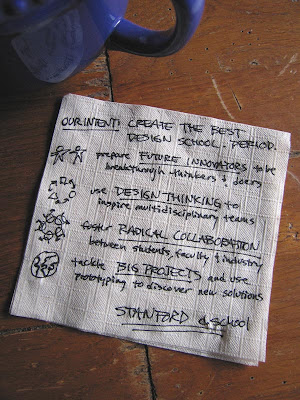Designing a Design School

Every so often — more frequently lately — I am forced to reflect on how cloistered a life I lead, at least compared, say, to Richard Florida and other people who keep up with things useful. So he likely knew that Stanford has a newish Institute of Design, which they call a design school, or d.school for short.
The napkin plan above is, I kid you not, their official manifesto, or what they call the d.manifesto. Honest. Go here to their website and click on d.manifesto on the lower left corner of their incredibly effectively designed web site and all you get is the photo of the napkin plan above. Not a thing more. Beyond cool.
But this is not your mother’s design school. For example, it may be in the business school (or maybe not — I can’t tell what the chain of command is) and cofounded by engineering faculty. While industrial design might be the most visible focus, so far as I can tell they do not feel that lineage limits what they mean by design in the least. (There is no architecture school at Stanford or one can easily imagine how lively those naming debates would have been.)
I like this plan very much. UCLA announcement: We will soon be recruiting for a new dean. Dear readers, please send us candidates who will (a) advocate a plan of roughly this length, substance, and spirit, (b) really believe they can pull it off, and (c) figure out how to fully explain it, if not on a napkin, with roughly the same style and impact. (A yellow pad maybe? Chalk board?)
In addition to the manifesto, which I dare you to substantively critique, they have a similarly succinct and inviting “vision statement.” In its entirety:
Our Vision
A bold new design institute at Stanford
We have a dream about building a place for design at Stanford.
We want to build a place where design thinking is the glue that binds people together, a place we call the d.school.
We want the d.school to be a place for Stanford students and faculty in engineering, medicine, business, the humanities, and education to learn design thinking and work together to solve big problems in a human centered way.
We want it to be a place where people from big companies, start-ups, schools, nonprofits, government, and anyone else who realizes the power of design thinking, can join our multidisciplinary teaching, prototyping, and research.
The hair is standing up on the back of my neck. What a nervy bunch. By comparison, planning mission statements tend to drone on about every sector and constituency, as if feelings would be hurt or turf lost if we only referred to people and problems in general. While we start the meeting with pretty enough conceits, we often end up riding a camel.
I often like to think that planners are, at least in their hearts (and secret pithy, unpublished mission statements), the really clever movers and shakers at fixing the problems of places, the out of the box imaginers, the best intentioned doers, while b-schools types are dragging their knuckles in the muck of the search for mere material accumulation. Some, maybe most, b-schools types are but that’s not my point. My point is that these particular d.school folks appear so far ahead of many of us in boldness, ambition, and adventurous spirit that it is not in the least bit funny. Not even funny in a way.

Consider their logo. The prominent part of the institute name doesn’t even have words in it, yet is perfectly readable. (Once you know what it says anyway.) How did that get through the bureaucracy in one piece?
I realize part of the story here is money, Mr. Plattner’s money I suppose. But let’s face it, that’s the smallest part; you don’t need any cash to decide that planning/design — or whatever you want to call the study of the hows, whys and ways of place making — should start wearing bigger clothes and thinking bigger, powerful, inspiring thoughts about reinvention and purpose “… to work together to solve big problems in a human centered way.” How do you think they got Mr. Plattner’s money in the first place? (Even better, see here for his explanation.) The ideas, clarity, and forcefulness came well before the slick html.
Am I sputtering? I am impressed and don’t mind being vulnerable enough with you for a minute to share that. I wish them all the best … and us too.
- Published:
- Sunday, November 18th, 2007
- Author:
- randall Crane
- Topics:
- academic life, metrics
Blogroll
- Becker-Posner blog
- BLDG BLOG
- Burb
- CityStates
- Curbed LA
- Cyburbia
- DemocraticSPACE
- Environmental and Urban Economics
- Freakonomics
- LA Transportation Headlines
- Peter Gordon’s Blog
- Planetizen
- The Center for Land Use Interpretation
- The Transportationist
- the urban commons
- This week’s finds in planning
- Urbanicity
Journals
- Cityscape
- environment and planning a,b,c,d
- Harvard Design Magazine
- Housing Policy Debate
- Housing Studies
- International Development Planning Review
- International Journal of Urban and Regional Research
- International Regional Science Review
- Journal of Architectural and Planning Research
- Journal of Housing Economics
- Journal of Planning Education and Research
- Journal of Planning Literature
- Journal of Regional Science
- Journal of the American Planning Association
- Journal of Urban Affairs
- Journal of Urban Economics
- Planning Theory
- Regional Science & Urban Economics
- Transportation Research Parts A,B,C,D,E,F
- Urban Studies
- World Development
Comments are closed
Comments are currently closed on this entry.